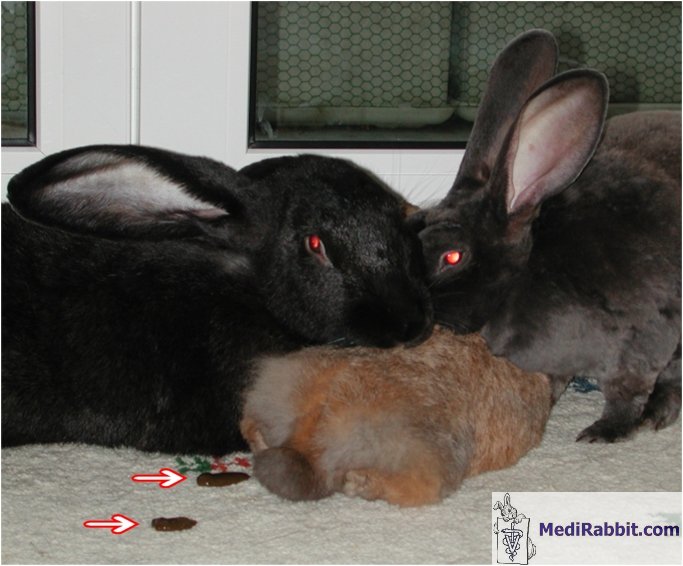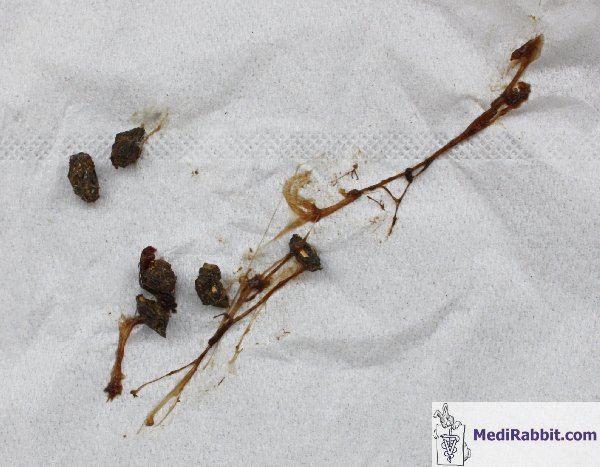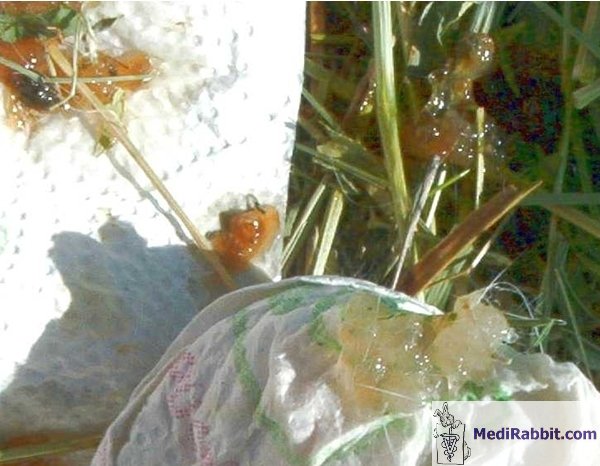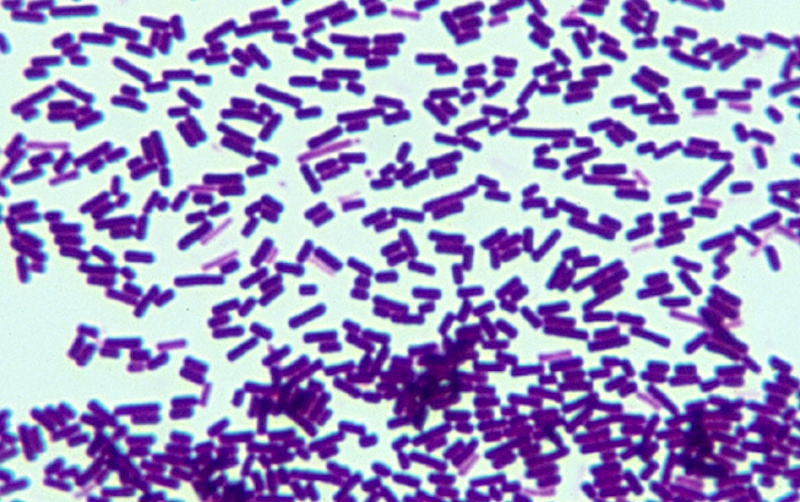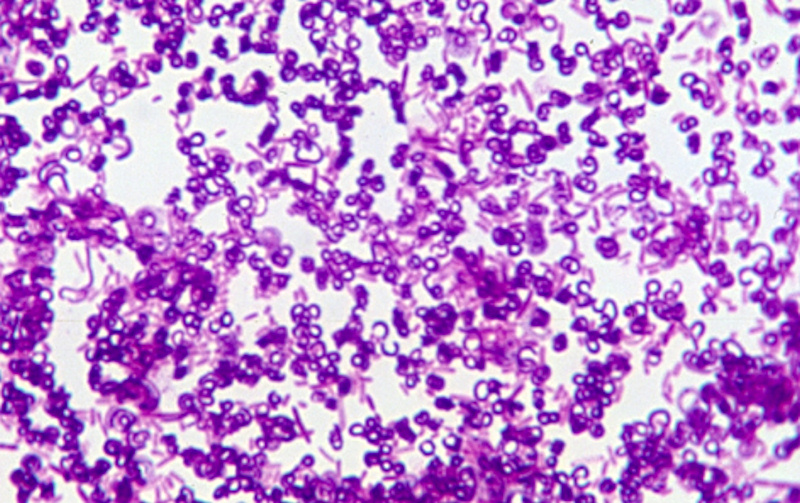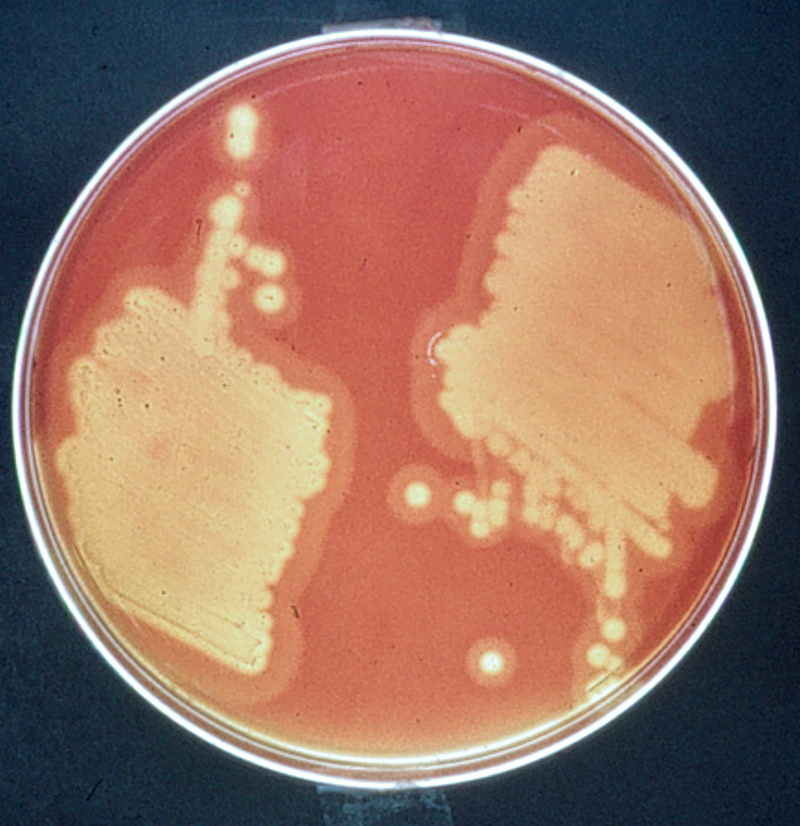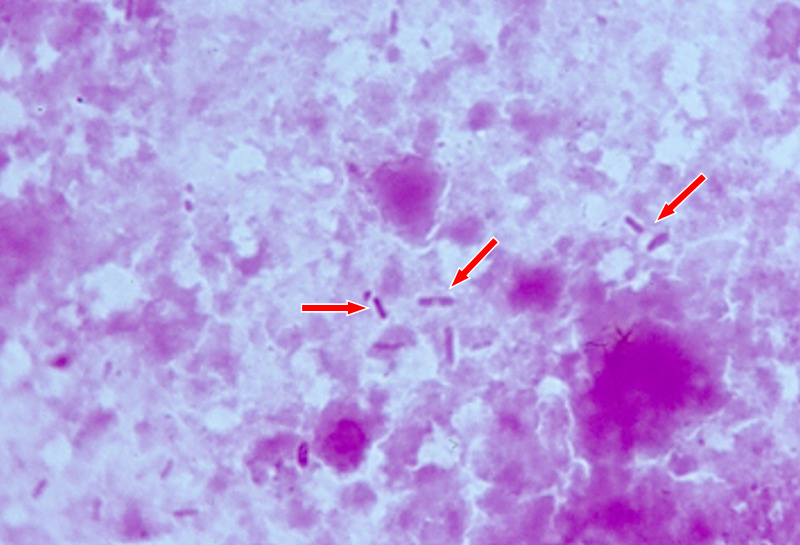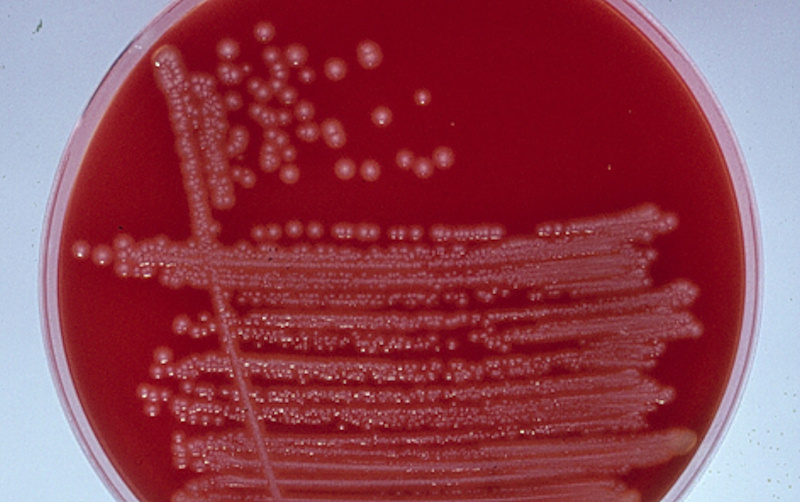Bacterial enteritis and diarrhea in
weaned and adult rabbits
Esther van Praag, Ph.D.
|
MediRabbit.com is
funded solely by the generosity of donors. Every
donation, no matter what the size, is appreciated and will aid in the continuing
research of medical care and health of rabbits. Thank you |
Warning: this file contains pictures
that may be distressing to some persons
|
In rabbits, health of the digestive system is considered
as the basis of the general health of the animal. There is no specific and
unique cause that leads to a disruption of digestive transit, but a
combination of factors: stress, the shift from a milk diet to an herbivore
diet in weaning rabbits, hygiene, parasites, molting and trichobezoar (mass
of fur hair in the stomach) and dental problems. In response, rabbits respond
with intestinal disturbances characterized by the onset of diarrhea. Newborns
are not much concerned because they are protected by milk produced by the
doe, which has antibacterial properties that prevent the growth of pathogenic
bacteria. Newly weaned 4- to 7-week-olds suffer mainly from enterotoxemia
with the almost complete destruction of the intestinal flora. After this age,
young rabbits and adults suffer from mucoid enteritis, with partial
destruction of the bacterial flora. Diarrhea Intestinal diarrhea in rabbits is favored by the
following facts: 1.
The rabbit is a very nervous
animal which is unable to adjust well its alarm response (adrenaline
discharge) to the gravity of the situation. 2. The rabbit
has a particular intestinal physiology, characterized by coprophagy
(cecotrophy - reingestion of feces produced in the cecum). During a period of
stress, the hormone adrenalin is released in the blood, which affects the
nervous system and will slow down the activity of the intestine. Passage of
food is slowed down and coprophagie is stopped. 3. After a
stressful event, the cecum becomes more alkaline. This will affect the
intestinal environment, the intestinal bacterial flora and will allow the
growth of pathogen bacteria such as Escherichia coli or different species of the Clostridium
bacterium may become dominant.
4.
The appearance of a disease in
rabbits is generally delayed after a stress period, and diarrhea appears only
1 to 7 days after.
The clinical signs of digestive problems or enteritis
in rabbits are fairly constant. The first signs, which last 1 to 3 days,
remain generally unnoticed: decreased food intake by the rabbit and
constipation. The watery cecal feces are generally not eaten. After the 5th
day, moderate diarrhea, accompanied by skin dehydration appears. Diarrhea
consists of small quantities of liquid feces which soil the anal region and
hindquarter of the rabbit. Death can occur at this phase, sometimes even
before the diarrhea appears. Two or three days later, the acute form of the
illness develops. The rabbit stops eating drinking and suffer from extensive
diarrhea. Teeth grinding can be heard, as a result of severe intestinal pain
and discomfort and the rabbit may suffer an agitated comatose state. At this
stage prognosis is poor and the rate of mortality is high. Animals that
remained comatose during a full day can, however, survive when given
appropriate care, and recover within a few days. A post mortem examination of the intestine
show atypical lesions. During the acute phase of the disease, the intestinal
wall appears bruised or congested. The content is watery. The cecum looks
congested, marked with red brushstrokes, and is filled with gas and little
food.
Causes
There are specific and non-specific causes for
diarrhea. Young rabbits respond badly to stress (especially during
the post-weaning period), transport, to unidentified noises, to a new
environment and to new persons or animals. Modifications of the diet or a
diet low in fibers can, furthermore, lead to digestive disorders. Usually,
food alone is not the main trigger of diarrhea, but rather its composition,
such as a low percentage of crude fiber, too rich in carbohydrates or
proteins, too finely ground food or improper watering, or the introduction of
a new sort of vegetable or fruit. Viruses and pathogen bacterial overgrowth of e.g. Corynebacteria sp., Clostridium sp., Pasteurella sp.
and Escherichia coli cause
enteritis. The occurrence of Salmonella sp. is, however, rare in
rabbits. The presence of intestinal parasites such as trematodes (flukes),
cestodes (tapeworms), nematodes (Parasitic intestinal
worms), and protozoa (coccidiosis) can also lead to digestive disorders in rabbits, with onset of
stasis and diarrhea.
Further causes of diarrhea include the
administration of drugs or antibiotics (see: “Antibiotics
dangerous for use in rabbits”), or the presence of nitrate in the
drinking water. Bacterial and Mucoid enteritis
Mucoid diarrhea is sometimes observed in growing rabbits and nursing
does. The watery feces are mixed with mucus, a translucent and gelatinous
substance. This particular type of enteritis has various causes, including
bacterial overgrowth or nutritional deficiencies (lack of water and food low
in fiber).
Bacterial enteritis develops very rapidly, within 3 to 4 days and
leads to death before the appearance of diarrhea. Bacteria such as Clostridium perfringens and Escherichia coli cause
intestinal enteritis. In healthy rabbits the number of Escherichia coli
bacteria present in the fecal droppings is low (102-103/g
drops), but in cases of diarrhea, they are systematically present in high
number. The bacterium produces toxins, but it has been shown that these alone
do not lead to the onset of diarrhea. It needs a supplemental source of
stress to induce diarrhea, such as a non-balanced diet or a thermal choc
(sudden change of weather, drop of temperature or atmospheric pressure).
Clostridium perfringens exists in 5 forms and is classified according to the production of
toxins. These toxins induce local lesions in the intestine, but their action may
also affect distant organs such as the liver and the kidney. Escherichia
coli possess five general mechanisms to invade the intestine and cause
the disease. Sometimes there is production of toxins. The bacterium invades
the intestine by adhering on the villi of enterocytes and begins to
proliferate. The presence of toxins stimulates the secretion of water and
electrolytes by the intestinal mucosa. Proliferation of bacteria and
production of toxin together can lead to diarrhea. Both above bacteria are often associated to the presence of coccidia.
Treatment
As the disease develops
very rapidly, treatment of bacterial enteritis often comes too late because
the evolution of the disease is fast and the rabbit is severally dehydrated.
Antibiotics, including sulfonamide drugs, may help prevent the growth of
pathogen bacteria. Anti-diarrhea product can help stop the diarrhea, e.g.
Hylak, a concentrate of lactic ferments. Cholestyramine will bind toxins
released by pathogen bacteria such as the alpha toxins produced by Clostridium
perfringens. Probiotic powders or paste, although controversial, will support
the growth of the endemic healthy bacterial flora. If the rabbit is
dehydrates, it should be given oral fluids with a syringe or subcutaneous
fluids. If the rabbit refuses to eat, intake of food must be forced using a
syringe.
Various veterinary products are available to feed a sick rabbit. Homemade
food can also be prepared, using the usual pelleted food, finely grinded in a
coffee grinder, a few drops of olive oil and plant-based baby food (pumpkin,
carrot, apple, etc.) diluted in lukewarm water in order to obtain a smooth
paste that can be easily taken up in a syringe. Even if controversial,
virgin cold-pressed olive oil has several properties that help against
constipation or diarrhea. Its presence in the intestine stimulates the
secretion of digestive fluids such bile, lightly stimulates peristaltic
movement of the intestine and lubricates the intestinal wall. It does,
furthermore, promote the growth of healthy intestinal bacteria. In the case of yeast overgrowth,
food rich in carbohydrates should be reduced. The lack of sugars will lead to
a decrease of the yeast population in the intestine. If this is not helping,
an antifungal drug like nystatin can be given to the rabbit. Plants with medicinal or other properties can
help stop the diarrhea or help recovery of the rabbit after the disease. They
are presented in the bellow tables.
Acknowledgements
All
my gratitude to Prof. Richard Hoop (Institut für Veterinärbakteriologie,
University of Zurich, Switzerland), to Kim Chilson
(USA), and to Tal Saarony for the permission to use their pictures. Thank you
also to Adar, Flora, and Stampi for their help in illustrating this article. Further
Information Bryskier A, Doll J, Labro MT, Andrieu J. Role of Clostridium
and its toxin in pseudo-membranous colitis. Ann Biol
Clin (Paris). 1981;39(1):1-8. Jones JR, Duff JP. Rabbit epizootic enterocolitis. Vet Rec. 2001 Oct
27;149(17):532. Hoop RK, Ehrsam H, Keller
B. 10 years of rabbit autopsy--a review of frequent disease and mortality
causes. Schweiz Arch Tierheilkd.
1993; 135(6-7):212-6. Humphrey CD, Condon CW, Cantey JR, Pittman
FE. Partial purification of a toxin found in hamsters with
antibiotic-associated colitis. Reversible binding of the toxin by
cholestyramine. Gastroenterology. 1979 Mar;76(3):468-76. Licois D. Tyzzer's disease. Ann Rech Vet.
1986; 17(4):363-86. Sinkovics G. Rabbit
dysentery: 3. Diagnostic differentiation. Vet Rec. 1978 Oct 7; 103(15):331-2.
Patton NM, Holmes HT, Riggs RJ, Cheeke PR. Enterotoxemia in rabbits. Lab Anim
Sci. 1978; 28(5):536-40. Patton NM, Holmes HT, Riggs RJ, Cheeke PR. Enterotoxemia in rabbits. Lab Anim
Sci. 1978; 28(5):536-40. Tribe GW,
Whitbread TJ, Watson GL. Fatal enteritis in rabbits associated with a spirochaete. Vet Rec. 1989; 124(22):595. |
|||||||||||||||||||||||||||||||||||||||||||||||||||||||||||||||||||||||||||||||||||||||||||||||||||||||||||||||||||||||||||||||||||||||||||



